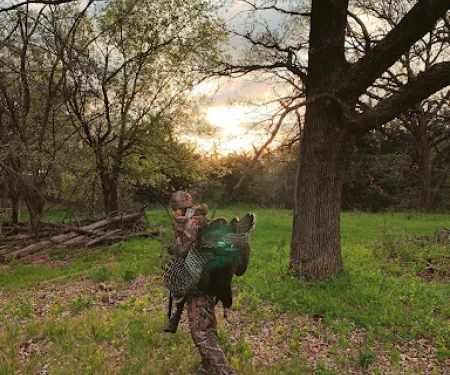New Rules 2021-2022 Turkey Regulations
Oklahoma's Wild Turkeys
The wild turkey (Meleagris gallopavo) is represented in Oklahoma by three subspecies: Eastern, Rio Grande and Merriams. Hybridization occurs where their ranges overlap. Wild turkeys are large birds, with adult toms often weighing more than 20 pounds. Both sexes have long legs and broad wings and are swift runners and powerful flyers. Both have long necks which, when the birds are alert, extend upward to improve visibility. They also have excellent vision and hearing and both sexes may come to a hunter's call. However, only toms are legal during fall and spring hunting seasons and hunters must learn to distinguish between hens and toms. Generally, males are larger, darker, and more brilliantly colored than females.
Rio Grande Turkey
This subspecies inhabits a much wider range than it did originally, partly because these birds were more available than Eastern turkeys during the era of restorations. They were able to adapt easily, reproduce successfully and expand quickly all through the west, cross timbers areas, and finally into the hill country of mid-eastern Oklahoma. Today, populations are stable, and trap and transplant operations are seldom used.
These turkeys are no longer confined to river systems since roost sites are now available in tree rows, shelterbelts, and upland timber, which was not available before man settled the Oklahoma prairie. This has dispersed populations of birds across the western three-fourths of the state, and made them more accessible to sportsmen. Turkey hunters have a legitimate chance to bag a spring tom on many of the Department’s lands open to public hunting.
On wildlife management areas, biologists enhance turkey habitat by planting winter food plants such as wheat, rye grass, or alfalfa, renewing plant succession by burning or disking, planting mast trees such as oaks and pecans, and planting roost trees (mostly cottonwoods) in areas that are otherwise suitable for supporting populations. Moderate grazing, like that observed on some wildlife management areas, can help enhance poult rearing and feeding areas.
Eastern Turkeys
Oklahoma’s current population of Eastern wild turkeys is within a range much smaller than it was originally. Generally confined to the rugged mountains of southeast and far eastern Oklahoma, the population status of this subspecies is considered less stable than its western Oklahoma cousin.
Eastern turkey populations spiked in the 1980s, but the weather for reproduction and poult survival led to depressed populations by the early 1990s. Better weather for successful nesting and poult production has recently led to dramatic increases in Eastern turkey flocks.
On wildlife management areas, biologists are using new knowledge and understanding of the Eastern turkey to enhance habitat. Once it was thought that the Eastern subspecies had evolved to become a creature of undisturbed forest – a theory which has been disproved. Openings in the forest canopy are now seen as critically important for poult production and brooding areas. Dense underbrush in these openings provides nesting sites while open ground makes good “bugging” areas for turkeys, especially poults. Managers have begun opening such plots amid previously undisturbed forest.
Green winter food plots and renewal of plant succession through prescribed burning or disking are also good management technique in eastern range. Mast and roost trees are generally not as lacking as they are in the west, but in some areas planting these trees is still a part of management plans.
For additional information on Oklahoma Turkey Sub-Species go here.



